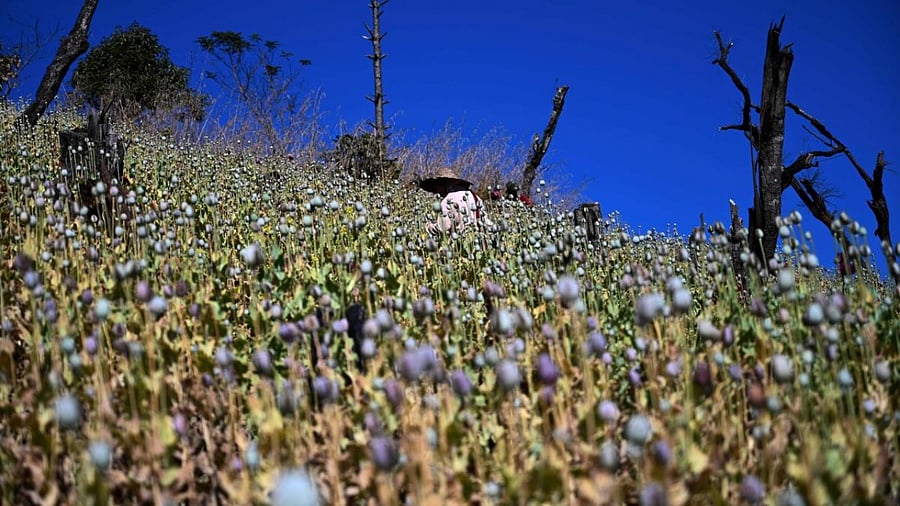
There has been a spate of high-profile seizures of narcotics and psychotropic substances in India in the last few months. What has been disturbing is not only the quantity of drugs seized but also the various modes adopted: sea, land and air.
The trend started even before the Taliban takeover of Afghanistan; thus late 2020 and early 2021 have witnessed huge seizures of high-grade heroin. 191 kgs in JNPT port followed by 135 kgs in Mumbai and 283 kgs and 191 kgs again in JNPT port, apart from regular seizures, from passengers trying to sneak it in through airports, as also cases of ingress through the Indo-Pak and Indo-Myanmar borders.
Geography is, as has been said, destiny. This cannot be truer than in the case of India in the context of the drug problem. Wedged between the Golden Crescent and the Golden Triangle, India has a substantial land border with the opium-producing regions. Afghan-cultivated opium distilled into heroin, in labs dotting both sides of the Afghan-Pakistan border, enters India through the 3,300-km-long border with Pakistan. We also have about a 1,600-kms-long border with Myanmar.
This has meant a constant battle to prevent the smuggling of heroin. India is particularly vulnerable also because it manufactures precursor chemicals essential for distilling opium into heroin. These chemicals are manufactured for licit usage but get diverted for the manufacturing of heroin. The National Drug Threat Assessment, 2020, of the US Drug Enforcement Agency, suggests that there is also a reverse flow of precursor chemicals from India.
In this background, we should review the dramatic developments in Afghanistan over the last few weeks. Afghanistan, after the Taliban takeover, is a country ravaged by the effects of war and poverty, struggling to settle down. With a population of just under 34 million with 54% living under the poverty line, ranked among the countries with the lowest gross domestic product by capita at $580.82, Afghanistan desperately needs economic aid.
The world today is, on the contrary, choking financial aid to Afghanistan. The International Monetary Fund’s (IMF) mandate is to help countries tide over economic crises; under pressure from the Biden administration, it has, however, blocked Afghanistan from accessing emergency reserves. $455 million in SDR’s due to Afghanistan has been held back. Further, the US Treasury Department has frozen $9.4 billion of reserves held by DAB, the Afghan Central Bank in the New York Federal reserve and US-based financial institutions. The consequence is a huge financial and humanitarian crisis in Afghanistan.
Worse, what this financial crisis will mean is that the Taliban may turn to drugs to fund their activities. While there can be no justification for drug peddling, it should not be forgotten that Afghanistan produces nearly 90% of the world’s illicit opium. As per UNODC, nearly 2,24,000 ha of land is under opium cultivation, in 22 out of the 34 provinces in the country. In 2020 the UN estimated that nearly 6,300 tonnes of opium were cultivated, with a farm gate value of $350 million which when it reaches the markets multiplies many times. It is estimated that the opium trade is worth between 6-11% of Afghanistan’s GDP. Drug trafficking, apart from hurting societies, triggers a host of other criminal activities and worse, finances terrorism. Afghanistan has also discovered that the ephedra plant which is a major source for methamphetamine grows there, providing yet another conduit for illicit fund generation.
The Taliban spokesman recently did make a brave statement that ‘Afghanistan will not be a country for the cultivation of opium anymore’. However, this seems unlikely. The financial stress and tacit persuasion of a myopic Pakistan will result in the Taliban resorting to even more unchecked cultivation of opium. As Gretchen Peters has pointed out, the Taliban has always profited from opium. While the Balkan route and Tajikistan are the popular drug routes, India, because of its proximity, convenient access through Pakistan and a growing drug problem, cannot escape the consequences.
While enforcement agencies seek to choke supplies, it is equally important to curb demand. Creating awareness about the ill-effects of drugs among the population is essential. We must not forget that the continuing stressful conditions caused by the pandemic—the deaths, illness, loss of jobs, shutdowns are fertile ground for seeking solace in the world of drugs. A 2019 survey by the Ministry of Social Justice and Empowerment ’Magnitude of Substance Use in India’ shows opioids (heroin, smack brown sugar) are used by about 2.1% of the population. This translates to a whopping 2.26 crore people, and as the seizures indicate, growing by the day.
Creating awareness would mean engaging social organisations and educational institutions, reducing stigmatization and rehabilitating addicts, organising visits to de-addiction camps to witness firsthand the debilitating impact of drugs and more. Remarks like those of the Bishop, that a ‘Narcotics Jihad’ is being waged, even though made with the best of intentions, do not help. It distracts from the fact that it is the demand which spurs supplies. It ignores the fact that India too is a cultivator of opium, licit, but that we do have a problem of some leakage of opium which makes its way into the illegal domestic market.
We must, for more reasons than one, be acutely conscious of the happenings in Afghanistan. The Taliban is likely to push opium to various markets to fund their activities. We have to tackle the menace from both the supply and demand ends. We cannot afford to let the menace of drugs go out of hand.
(The writer is a former chairman of the Central Board of Indirect taxes & Customs)